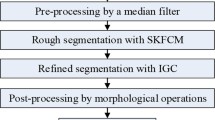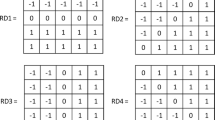Abstract
The entire community of medical experts uses various imaging techniques as the precursor for disease diagnosis with the assistance of computer-aided diagnosis systems. In many cases, these imaging techniques savored the status of pivotal proof of occurrence for tissue abnormalities. One of the most important steps in the analysis of tissue using medical images is the correct approximation of position, size, and shape of the lesion which plays a significant role to decrease false positives count for effective diagnosis of renal lesions. This article suggests a hybrid segmentation technique based on two methods which include spatial intuitionistic fuzzy c-means clustering (SIFCM) that integrates spatial image details and, distance regularized level-sets method for extraction of renal lesions correctly and proficiently in computed tomography (CT) images. The proposed technique works by taking an approximation of region of interest (ROI) given by Spatial IFCM clustering (SIFCM) for correct demarcation of lesions. Further, the performance of the suggested technique is tested on the considered image dataset and compared with the other state-of-the-art segmentation techniques such as thresholding, region growing, level set, fuzzy c-means clustering (FCM), active contour without edges (ACWE), geodesic active contours (GAC), spatial FCM and intuitionistic FCM. To confirm the segmentation results, the ground truth marked by the expert radiologists was considered as a gold standard for comparison. The experimental outcomes reveal that the suggested technique yields the results close to the manual delineations of experts as compared to the other considered segmentation techniques and is able to segment lesion correctly and precisely. The suggested technique attains the better lesion segmentation, even for images with low-contrast and in the presence of noise components. Furthermore, it possesses the capability to control the parameters adaptively from SIFCM clustering method.



Similar content being viewed by others
References
Ahmed MN, Yamany SM, Mohamed N, Farag AA, Moriarty T (2002) A modified fuzzy c-means algorithm for bias field estimation and segmentation of MRI data. IEEE Trans Med Imaging 21(3):193–199. https://doi.org/10.1109/42.996338
Archip N, Jolesz FA, Warfield SK (2007) A validation framework for brain tumor segmentation. Acad Radiol 14(10):1242–1251
Belongie S, Malik J, Puzicha J (2002) Shape matching and object recognition using shape contexts. IEEE Trans Pattern Anal Mach Intell 24(4):509–522
Bluth EI, Bush WH, Amis ES, Bigongiari LR, Choyke PL, Fritzsche PJ, Holder LE, Newhouse JH, Sandler CM, Segal AJ, Resnick MI (2000) Indeterminate renal masses: American College of Radiology. ACR Appropr Criteria Radiol 215:747–752
Cai W, Chen S, Zhang D (2007) Fast and robust fuzzy c-means clustering algorithms incorporating local information for image segmentation. Pattern Recogn 40(3):825–838. https://doi.org/10.1016/j.patcog.2006.07.011
Campbell SC, Novick AC, Belldegrun A, Blute ML, Chow GK, Derweesh IH, Faraday MM, Kaouk JH, Leveillee RJ, Matin SF, Russo P (2009) Guideline for management of the clinical T1 renal mass. J Urol 182(4):1271–1279. https://doi.org/10.1016/j.juro.2009.07.004
Chan TF, Vese LA (2001) Active contours without edges. IEEE Trans Image Process 10(2):266–277
Chen S, Zhang D (2004) Robust image segmentation using FCM with spatial constraints based on new kernel-induced distance measure. IEEE Trans Syst Man Cybern B (Cybern) 34(4):1907–1916. https://doi.org/10.1109/TSMCB.2004.831165
Choyke PL, Amis ES, Bigongiari LR, Bluth EI, Bush WH, Fritzsche P, Holder L, Newhouse JH, Sandler CM, Segal AJ, Resnick MI (2000) Renal cell carcinoma staging. American College of Radiology. ACR Appropr Criteria Radiol 215:721–725
Chuang KS, Tzeng HL, Chen S, Wu J, Chen TJ (2006) Fuzzy c-means clustering with spatial information for image segmentation. Comput Med Imaging Graph 30(1):9–15. https://doi.org/10.1016/j.compmedimag.2005.10.001
Fedkiw SO, Osher S (2002) Level set methods and dynamic implicit surfaces. Surfaces 44:77
Graves D, Pedrycz W (2010) Kernel-based fuzzy clustering and fuzzy clustering: a comparative experimental study. Fuzzy Sets Syst 161(4):522–543. https://doi.org/10.1016/j.fss.2009.10.021
Gupta D, Anand RS (2017) A hybrid edge-based segmentation approach for ultrasound medical images. Biomed Signal Process Control 1(31):116–126. https://doi.org/10.1016/j.bspc.2016.06.012
Kaur R, Juneja M (2016) A survey of different imaging modalities for renal cancer. Indian J Sci Technol 30(9):44–50. https://doi.org/10.17485/ijst/2016/v9i44/105067
Kaur R, Juneja M (2018) Comparison of different renal imaging modalities: an overview. In Progress in intelligent computing techniques: theory, practice, and applications (pp 47–57). Springer, Singapore. https://doi.org/10.1007/978-981-10-3373-5_4
Kaur R, Juneja M, Mandal AK (2018) A comprehensive review of denoising techniques for abdominal CT images. Multimed Tools Appl 1–36. https://doi.org/10.1007/s11042-017-5500-5
Kim DY, Park JW (2004) Computer-aided detection of kidney tumor on abdominal computed tomography scans. Acta Radiol 45(7):791–795
Lee HS, Hong H, Kim J (2017) Detection and segmentation of small renal masses in contrast-enhanced CT images using texture and context feature classification. In Biomedical Imaging (ISBI 2017), IEEE 14th International Symposium 18 (pp 583–586) https://doi.org/10.1109/ISBI.2017.7950588
Li C, Xu C, Gui C, Fox MD (2005) Level set evolution without re-initialization: a new variational formulation. In Computer Vision and Pattern Recognition. CVPR. IEEE Computer Society Conference 1 (pp 430–436) https://doi.org/10.1109/CVPR.2005.213
Li C, Xu C, Gui C, Fox MD (2010) Distance regularized level set evolution and its application to image segmentation. IEEE Trans Image Process 19(12):3243–3254. https://doi.org/10.1109/TIP.2010.2069690
Linguraru MG, Wang S, Shah F, Gautam R, Peterson J, Linehan WM, Summers RM (2011) Automated noninvasive classification of renal cancer on multiphase CT. Med Phys 38(10):5738–5746. https://doi.org/10.1118/1.3633898
Ljungberg B, Bensalah K, Bex A, Canfield S, Dabestani S, Hofmann F, Hora M, Kuczyk MA, Lam T, Marconi L, Merseburger AS (2013) Guidelines on renal cell carcinoma. Eur Assoc Urol 28
Osher S, Sethian JA (1988) Fronts propagating with curvature-dependent speed: algorithms based on Hamilton-Jacobi formulations. J Comput Phys 79(1):12–49. https://doi.org/10.1016/0021-9991(88)90002-2
Piao N, Kim JG, Park RH (2015) Segmentation of cysts in kidney and 3-D volume calculation from CT images. Int J Comput Graph Anim 5(1):1. https://doi.org/10.5121/ijcga.2015.5101
Siegel RL, Miller KD, Jemal A (2016) Cancer statistics 2016. CA Cancer J Clin 66(1):7–30. https://doi.org/10.3322/caac.21332
Smith RA, Andrews KS, Brooks D, Fedewa SA, Manassaram-Baptiste D, Saslow D, Brawley OW, Wender RC (2017) Cancer screening in the United States, 2017: a review of current American Cancer Society guidelines and current issues in cancer screening. CA Cancer J Clin 67(2):100–121. https://doi.org/10.3322/caac.21392
Summers RM, Agcaoili CM, McAuliffe MJ, Dalal SS, Yim PJ, Choyke PL, Walther MM, Linehan WM (2001) Helical CT of von Hippel-Lindau: semi-automated segmentation of renal lesions. In IEEE International Conference on Image Processing 2: (pp 293–296)https://doi.org/10.1109/ICIP.2001.958485
Thakur N, Juneja M (2018) Survey on segmentation and classification approaches of optic cup and optic disc for diagnosis of glaucoma. Biomed Signal Process Control 30(42):162–189. https://doi.org/10.1016/j.bspc.2018.01.014
Tolias YA, Panas SM (1998) On applying spatial constraints in fuzzy image clustering using a fuzzy rule-based system. IEEE Signal Process Lett 5(10):245–247. https://doi.org/10.1109/97.720555
Turner RM, Morgan TM, Jacobs BL (2017) Epidemiology of the small renal mass and the treatment disconnect phenomenon. Urol Clin 44(2):147–154. https://doi.org/10.1016/j.ucl.2016.12.001
Acknowledgements
This research work has been funded by University Grant Commission (UGC), New Delhi, India. Additionally, the authors would like to thank Prof. Anupam Lal, Department of Radio-diagnosis, PGIMER, Chandigarh for his support in carrying out this research.
Author information
Authors and Affiliations
Corresponding author
Ethics declarations
Conflict of interest
Authors have no conflict of interest
Additional information
Publisher’s Note
Springer Nature remains neutral with regard to jurisdictional claims in published maps and institutional affiliations.
Rights and permissions
About this article
Cite this article
Kaur, R., Juneja, M. & Mandal, A.K. A hybrid edge-based technique for segmentation of renal lesions in CT images. Multimed Tools Appl 78, 12917–12937 (2019). https://doi.org/10.1007/s11042-018-6421-7
Received:
Revised:
Accepted:
Published:
Issue Date:
DOI: https://doi.org/10.1007/s11042-018-6421-7




